Assessment of Climate Change Impacts on Water Quality in a Tidal Estuarine System Using a Three-Dimensional Model
Abstract
:1. Introduction
2. Materials and Methods
3. Materials and Methods
3.1. Hydrodynamic Model
3.2. Water Quality Model
3.3. Model Schematization and Implementation
4. Model Validation
4.1. Salinity Distribution
4.2. Water Quality Distribution
5. Model Project Responses to Climate Change Impact
6. Discussion
7. Conclusions
Acknowledgments
Author Contributions
Conflicts of Interest
References
- Hobbie, J.E. Estuarine Science—A Synthetic Approach to Research and Practice; Island Press: Washington, DC, USA, 2000. [Google Scholar]
- Pendleton, L.H. The Economic and Market Value of Coasts and Estuaries: What’s at Stake; Restore America’s Estuaries: Arlington, VA, USA, 2008; p. 182. [Google Scholar]
- Yoskowitz, D.W.; Santos, C.; Allee, B.; Carollo, C.; Henderson, J.; Jordan, S.; Ritchie, J. Ecosystem Services in the Gulf of Mexico. In Proceedings of the Gulf of Mexico Ecosystem Services Workshop, Bay St. Louis, MS, USA, 16–18 June 2010; Harte Research Institute for Gulf of Mexico Studies: Corpus Christi, TX, USA, 2010; p. 16. [Google Scholar]
- Skerratt, J.; Wild-Allen, K.; Rizwi, F.; Whitehead, J.; Coughanowr, C. Use of a high resolution 3D fully coupled hydrodynamic, sediment and biogeochemical model to understand estuarine nutrient dynamics under various water quality scenarios. Ocean Coast. Manag. 2013, 83, 52–66. [Google Scholar] [CrossRef]
- Yoskowitz, D.W.; Werner, S.R.; Carollo, C.; Santos, C.; Washburn, T.; Isaksen, G.H. Gulf of Mexico offshore ecosystem services: Relative evaluation by stakeholders. Mar. Policy 2015, in press. [Google Scholar] [CrossRef]
- Lee, R.W. Research of Construct Wetland Environment Model for Guandu Natural Park. Master’s Thesis, National Taiwan Ocean University, Keelung, Taiwan, 2012. [Google Scholar]
- Daily, G.C. Introduction: What are Ecosystem Services? Nature’s Services: Societal Dependence on Natural Ecosystems; Island Press: Washington, DC, USA, 1997. [Google Scholar]
- Chau, K.W. An unsteady three-dimensional eutrophication model in Tolo harbour, Hong Kong. Mar. Pollut. Bull. 2005, 51, 1078–1084. [Google Scholar] [CrossRef] [PubMed]
- McGlathery, K.J.; Sundback, K.; Anderson, I.C. Eutrophication in shallow coastal bay and lagoons: The role of plants in the coastal filter. Mar. Ecol. Prog. Ser. 2007, 348, 1–18. [Google Scholar] [CrossRef]
- Wild-Allen, K.; Skerratt, J.; Whitehead, J.; Rizwi, F.; Parslow, J. Mechanisms driving estuarine water quality: A 3D biogeochemical model for informed management. Estuar. Coast. Shelf Sci. 2013, 135, 33–45. [Google Scholar] [CrossRef]
- Kennish, M.J. Environmental threats and environmental future of estuaries. Environ. Conserv. 2002, 29, 78–107. [Google Scholar] [CrossRef]
- Paerl, H.W.; Valdes, L.M.; Peierls, B.L.; Adolf, J.E.; Harding, L.W. Anthropogenic and climatic influences on the eutrophication of large estuarine ecosystem. Limnol. Oceanogr. 2006, 51, 448–462. [Google Scholar] [CrossRef]
- Rabalais, N.N.; Turner, R.E.; Diaz, R.J.; Justic, D. Global change and eutrophication of coastal waters. ICES J. Mar. Sci. 2009, 66, 1528–1537. [Google Scholar] [CrossRef]
- McKibben, S.M.; Watkins-Brandt, K.S.; Wood, A.M.; Hunter, M.; Forster, Z.; Hopkins, A.; Du, X.; Eberhart, B.T.; Peterson, W.T.; White, A.E. Monitoring Oregon coastal harmful algae: Observations and implications for a harmful algal bloom-monitoring project. Harmful Algae 2015, 50, 32–44. [Google Scholar] [CrossRef]
- Stone, M.C.; Hotchkiss, R.H.; Hubbard, C.M.; Fontaine, T.A.; Mearns, L.O.; Arnold, J.G. Impacts of climate change on Missouri River Basin water yield. J. Am. Water Resour. Assoc. 2001, 37, 1119–1129. [Google Scholar] [CrossRef]
- Chang, H.; Knight, C.G.; Staneva, M.P.; Kostov, D. Water resource impacts of climate change in southwestern Bulgaria. Geojournal 2002, 57, 159–168. [Google Scholar] [CrossRef]
- Moss, R.H.; Edmonds, J.A.; Hibbard, K.A.; Manning, M.R.; Ross, S.K.; Van Vuuren, D.P.; Carter, T.R.; Emori, S.; Kainuma, M.; Kram, T.; et al. The next generation of scenarios for climate change research and assessment. Nature 2010, 463, 747–756. [Google Scholar] [CrossRef] [PubMed]
- Trenberth, K.E. Framing the way to relate climate extremes to chimate change. Clim. Change 2012, 115, 283–290. [Google Scholar] [CrossRef]
- Feng, S.; Hu, Q.; Hung, W.; Ho, C.H.; Li, R.; Tang, Z. Projected climate regime shift under future global warming from multi-model, multi-scenario CMIP5 simulations. Glob. Planet Change 2014, 112, 41–52. [Google Scholar] [CrossRef]
- Xin, X.; Zhang, L.; Zhang, J.; Wu, T.; Fang, Y. Climate change projection over East Asia with BCC_CSM1.1 climate model under RCP scenarios. J. Meteorl. Soc. Jpn. 2013, 91, 413–429. [Google Scholar] [CrossRef]
- Braks, M.; van Ginkel, R.; Wint, W.; Sedda, L.; Sprong, H. Climate change and public health policy: Translating the science. Int. J. Environ. Res. Public Health 2014, 11, 13–29. [Google Scholar] [CrossRef] [PubMed]
- Kendrovski, V.; Spasenovska, M.; Menne, B. The public health impacts of climate change in the former Yugoslav Republic of Mecedonia. Int. J. Environ. Res. Public Health 2014, 11, 5975–5988. [Google Scholar] [CrossRef] [PubMed]
- Petkova, E.P.; Ebi, K.L.; Culp, D.; Redlener, I. Climate change and health on the U.S. Gulf Coast: Public health adaption is needed to address future risks. Int. J. Environ. Res. Public Health 2015, 12, 9342–9356. [Google Scholar] [CrossRef] [PubMed]
- Luber, G.; Prudent, N. Climate change and human health. Trans. Am. Clin. Climatol. Assoc. 2009, 120, 113–117. [Google Scholar] [PubMed]
- Whitehead, P.; Wade, A.; Butterfield, D. Potential impacts of climate change on water quality and ecology in six UK rivers. Hydrol. Res. 2009, 40, 113–122. [Google Scholar] [CrossRef]
- Wu, Y.; Liu, S.; Gallant, A.L. Predicting impacts of increased CO2 and climate change on the water cycle and water quality in the semiarid James River Basin of the Midwestern USA. Sci. Total Environ. 2012, 430, 150–160. [Google Scholar] [CrossRef] [PubMed]
- Wetz, M.S.; Yoskowitz, D.W. An “extreme” future for estuaries? Effects of extreme climate events on estuarine water quality and ecology. Mar. Pollut. Bull. 2013, 69, 7–18. [Google Scholar] [CrossRef] [PubMed]
- Middelkoop, H.; Daamen, K.; Gellens, D.; Grabs, W.; Kwadijk, J.C.J.; Lang, H.; Parmet, B.W.; Schadler, B.; Schulla, J.; Wilke, K. Impact of climate change on hydrological regimes and water resources management in the Rhine Basin. Clim. Change 2001, 49, 105–128. [Google Scholar] [CrossRef]
- Ducharne, A.; Baubion, C.; Beaudoin, N.; Benoit, M.; Billen, G.; Brisson, N.; Garnier, J.; Kieken, H.; Lebonvallet, S.; Ledoux, E.; et al. Long term prospective of the Seine River system: Confronting climate and direct anthropogenic changes. Sci. Total Environ. 2007, 375, 292–311. [Google Scholar] [CrossRef] [PubMed]
- Robins, P.E.; Skov, M.W.; Lewis, M.J.; Gimenez, L.; Davies, A.G.; Malham, S.K.; Neill, S.P.; McDonald, J.E.; Whitton, T.A.; Jackson, S.E.; et al. Impact of climate change on UK estuaries: A review of past trends and potential projections. Estuar. Coast. Shelf Sci. 2016, 169, 119–135. [Google Scholar] [CrossRef]
- Garcia, A.; Juanes, J.A.; Alvarez, C.; Revilla, J.A.; Medina, R. Assessment of the response of a shallow macrotidal estuary to changes in hydrological and wastewater inputs through numerical modeling. Ecol. Model. 2010, 221, 1194–1208. [Google Scholar] [CrossRef]
- Zhou, N.; Westrich, B.; Jiang, S.; Wang, Y. A coupling simulation based on hydrodynamics and water quality model of the Pearl River Delta, China. J. Hydrol. 2010, 396, 267–276. [Google Scholar] [CrossRef]
- Piliwal, R.; Patra, R.R. Applicability of MIKE 21 to assess temporal and spatial variation in water quality of an estuary under the impact of effluent from an industrial estate. Water Sci. Technol. 2011, 63, 1932–1943. [Google Scholar] [CrossRef]
- Long, T.Y.; Wu, L.; Meng, G.H.; Guo, W.H. Numerical simulation for impacts of hydrodynamic conditions on algae growth in Chongqing Section of Jialing River, China. Ecol. Model. 2011, 222, 112–119. [Google Scholar] [CrossRef]
- Gao, G.; Falconer, R.A.; Lin, B. Modelling effects of a tidal barrage on water quality indicator distribution in the Severn Estuary. Front. Environ. Sci. Eng. 2013, 7, 211–218. [Google Scholar] [CrossRef]
- Hanfeng, Y.E.; Guo, S.; Li, F.; Li, G. Water quality evaluation in tidal river reaches of Liaohe River estuary, China using a revised QUAL2K model. Chin. Geogr. Sci. 2013, 23, 301–311. [Google Scholar]
- Sun, J.; Lin, B.; Jiang, G.; Li, K.; Tao, J. Modelling study on environmental indicators in an estuary. Proc. Inst. Civil Eng. Water Manag. 2014, 167, 141–151. [Google Scholar] [CrossRef]
- Seo, D.; Song, Y. Application of three-dimensional hydrodynamics and water quality model of the Youngsan River, Korea. Desalin. Water Treat. 2015, 54, 3712–3720. [Google Scholar] [CrossRef]
- Tu, J. Combined impact of climate and land use changes in streamflow and water quality in eastern Massachusetts, USA. J. Hydrol. 2009, 379, 268–293. [Google Scholar] [CrossRef]
- Rehana, S.; Mujumdar, P.P. River water quality response under hypothetical climate change scenarios in Tunga-Bhadra river, India. Hydrol. Process. 2011, 25, 3372–3386. [Google Scholar] [CrossRef]
- Luo, Y.; Ficklin, D.L.; Liu, X.; Zhang, M. Assessment of climate change impacts on hydrology and water quality with a watershed modeling approach. Sci. Total Environ. 2013, 450, 72–82. [Google Scholar] [CrossRef] [PubMed]
- Wan, Y.; Ji, Z.G.; Shen, J.; Hu, G.; Sun, D. Three dimensional water quality modeling of a shallow subtropical estuary. Mar. Environ. Res. 2012, 82, 76–86. [Google Scholar] [CrossRef] [PubMed]
- Cerco, C.F.; Noel, M.R. Twenty-year simulation of Chesapeake Bay water quality using the CE-QUAL-ICM eutrophication model. J. Am. Water Resour. Assoc. 2013, 49, 1119–1133. [Google Scholar] [CrossRef]
- Li, K.; Zhang, L.; Li, Y.; Zhang, L.; Wang, X. A three-dimensional water quality model to determine the environmental capacity of nitrogen and phosphorus in Jiaozhou Bay, China. Mar. Pollut. Bull. 2015, 91, 306–316. [Google Scholar] [CrossRef] [PubMed]
- Hsu, M.H.; Kuo, A.Y.; Kuo, J.T.; Liu, W.C. Procedure to calibrate and verify numerical models of estuarine hydrodynamics. J. Hydraul. Eng. 1999, 125, 166–182. [Google Scholar] [CrossRef]
- Liu, W.C.; Chen, W.B.; Hsu, M.H. Influence of discharge reductions on salt water intrusion and residual circulation in Danshuei River Estuary. J. Mar. Sci. Technol. 2011, 19, 596–606. [Google Scholar]
- Wang, C.F.; Hsu, M.H.; Kuo, A.Y. Residence time of Danshuei River estuary, Taiwan. Estuar. Coast. Shelf Sci. 2004, 60, 381–393. [Google Scholar] [CrossRef]
- Liu, W.C.; Liu, S.Y.; Hsu, M.H.; Kuo, A.Y. Water quality modeling to determine minimum instream flow for fish survival in tidal rivers. J. Environ. Manag. 2005, 76, 293–308. [Google Scholar] [CrossRef] [PubMed]
- Wang, C.F.; Hsu, M.H.; Liu, W.C.; Hwang, J.S.; Wu, J.T.; Kuo, A.Y. Simulation of water quality and plankton dynamics in the Danshuei River Estuary, Taiwan. J. Environ. Sci. Health A 2007, 42, 933–953. [Google Scholar] [CrossRef] [PubMed]
- Zhang, Y.L.; Baptista, A.M. SELFE: A semi-implicit Eulerian-Lagrangian finite-element model for cross-scale ocean circulation. Ocean Model. 2008, 21, 71–96. [Google Scholar] [CrossRef]
- Shchepetkin, A.F.; McWilliams, J.C. A method for computing horizontal pressure-gradient force in an oceanic model with a nonaligned vertical coordinate. J. Geophys. Res. 2003, 108. [Google Scholar] [CrossRef]
- Umlauf, L.; Buchard, H. A generic length-scale equation for geophysical turbulence models. J. Mar. Res. 2003, 61, 235–265. [Google Scholar] [CrossRef]
- Ambrose, R.B., Jr.; Wool, T.A.; Martin, J.L. The Water Quality Analysis Simulation Program, WASP5, Part A: Model Documentation; U.S. Environmental Protection Agency: Athens, GA, USA, 1993; p. 202.
- Chen, W.B.; Liu, W.C.; Hsu, M.H. Water quality modeling in a tidal estuarine system using a three-dimensional model. Environ. Eng. Sci. 2011, 28, 443–459. [Google Scholar] [CrossRef]
- Liu, W.C.; Chen, W.B.; Kuo, J.T. Modeling residence time response to freshwater discharge in a mesotidal estuary, Taiwan. J. Mar. Syst. 2008, 74, 295–314. [Google Scholar] [CrossRef]
- Chen, C.H.; Lung, W.S.; Yang, C.H.; Lin, C.F. Spatially variable deoxygenation in the Danshui River: Improvement in model calibration. Water Environ. Res. 2013, 85, 2243–2253. [Google Scholar] [CrossRef] [PubMed]
- Montgomery Watson Harza (MWH). Evaluation of Hydrodynamics and Water Quality Monitoring and Management in the Danshuei River Basin of New Taipei City; Report to New Taipei City Government; Montgomery Watson Harza (MWH): Broomfield, CO, USA, 2011. [Google Scholar]
- Bowie, G.L.; Mills, W.B.; Porcella, D.B.; Campbell, J.R.; Pagenkopf, J.R.; Rupp, G.L.; Johnson, K.M.; Chan, P.W.H.; Gherini, S.A. Rates, Constants, and Kinetics Formulations in Surface Water Quality Modeling, 2nd ed.EPA/600/3–85/040; Environmental Research Laboratory, Office of Research and Development, U.S. Environmental Protection Agency: Athens, GA, USA, 1985; p. 455.
- Gray, K.R.; Biddlestone, A.J. Composing-process parameters. Chem. Eng. 1973, 2, 71–76. [Google Scholar]
- Meyers, P.A.; Ryoshi, I. Lacustrine organic goechemistry—An overview of indicators of organic matter sources and diagenesis in lake sediments. Org. Geochem. 1993, 20, 867–900. [Google Scholar] [CrossRef]
- Emerson, S.; Hedges, J. Sediment diagenesis and benthic flux. In Treatise on Geochemistry, 2nd ed.; Henry, E., Heinrich, D.H., Karl, K.T., Eds.; Elsevier: Amsterdam, The Netherlands, 2013; pp. 293–319. [Google Scholar]
- Kim, T.; Sheng, Y.P.; Park, K. Modeling water quality and hypoxia dynamics in Upper Charlotte Harbor, Florida, U.S.A. during 2000. Estuar. Coast. Shelf Sci. 2010, 90, 250–263. [Google Scholar] [CrossRef]
- Water Resources Agency. Strengthening Sustainable Water Resources Utilization and Adaptive Capability to Climate Change; Final Report; Water Resources Agency: Nantun, Taiwan; Taichung, Taiwan, 2008. (In Chinese) [Google Scholar]
- Tung, C.P.; Lee, T.C.; Liao, W.T.; Chen, Y.J. Climate change impact assessment for sustainable water quality management. Terr. Atmos. Ocean. Sci. 2012, 23, 565–576. [Google Scholar] [CrossRef]
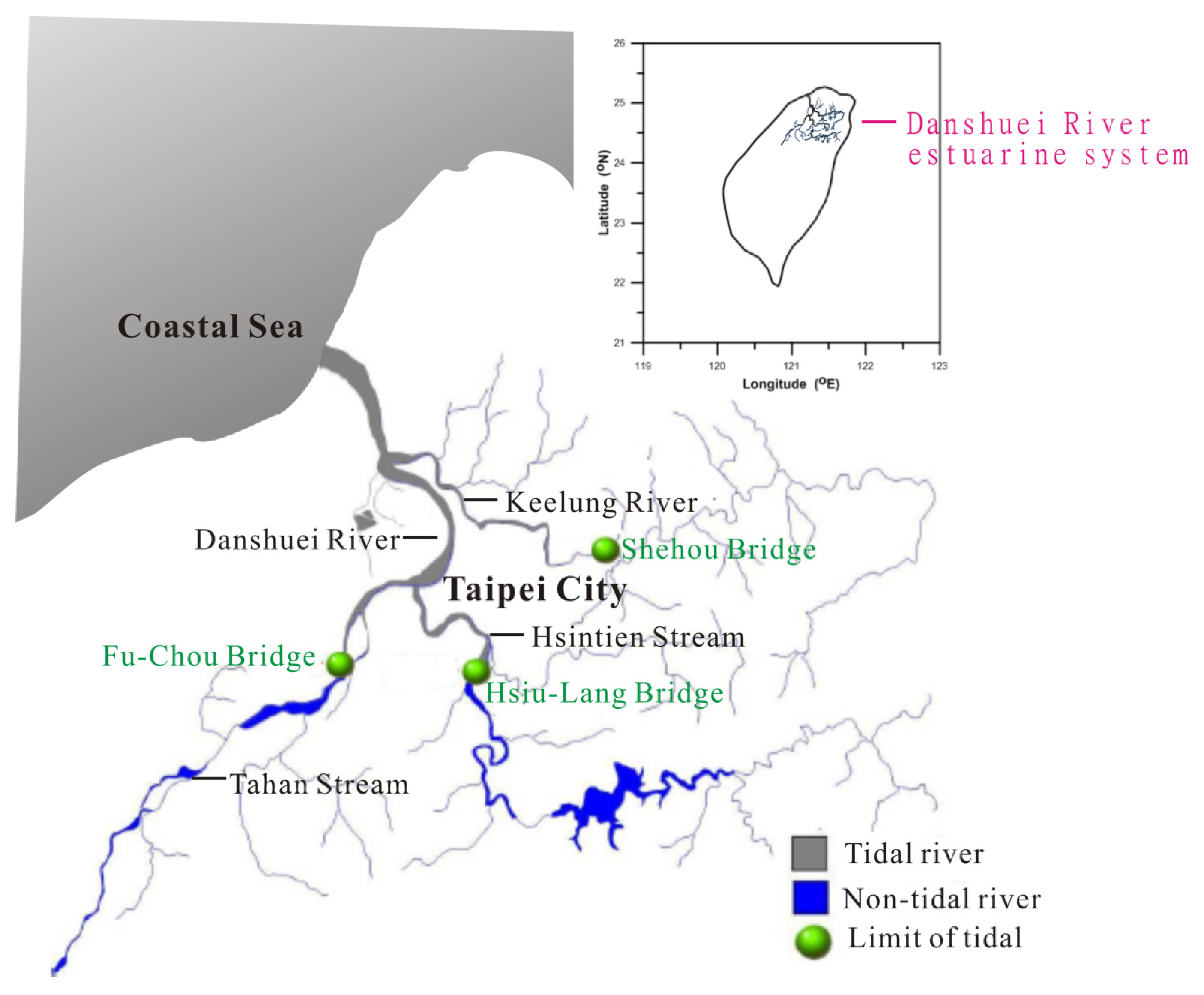

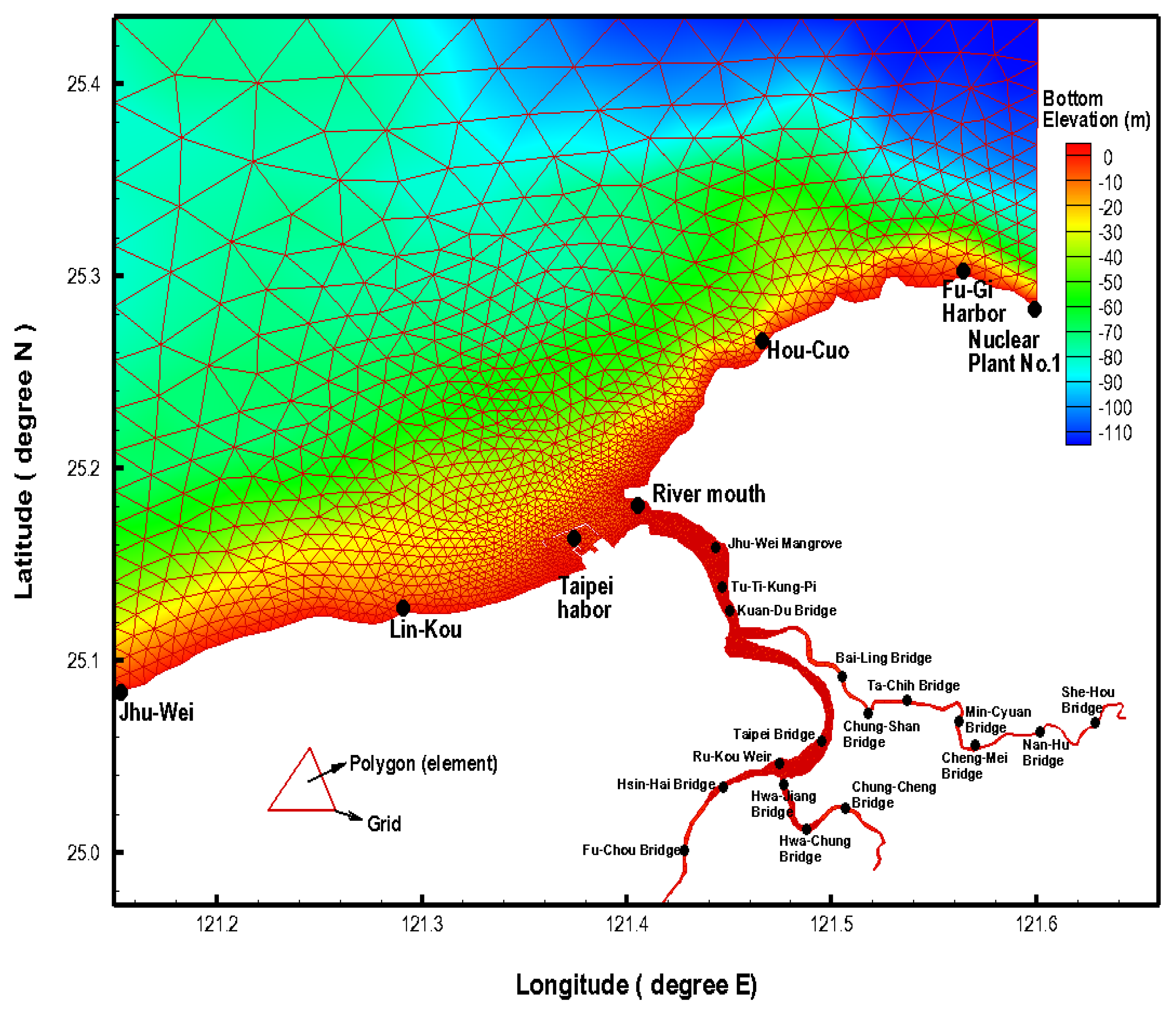
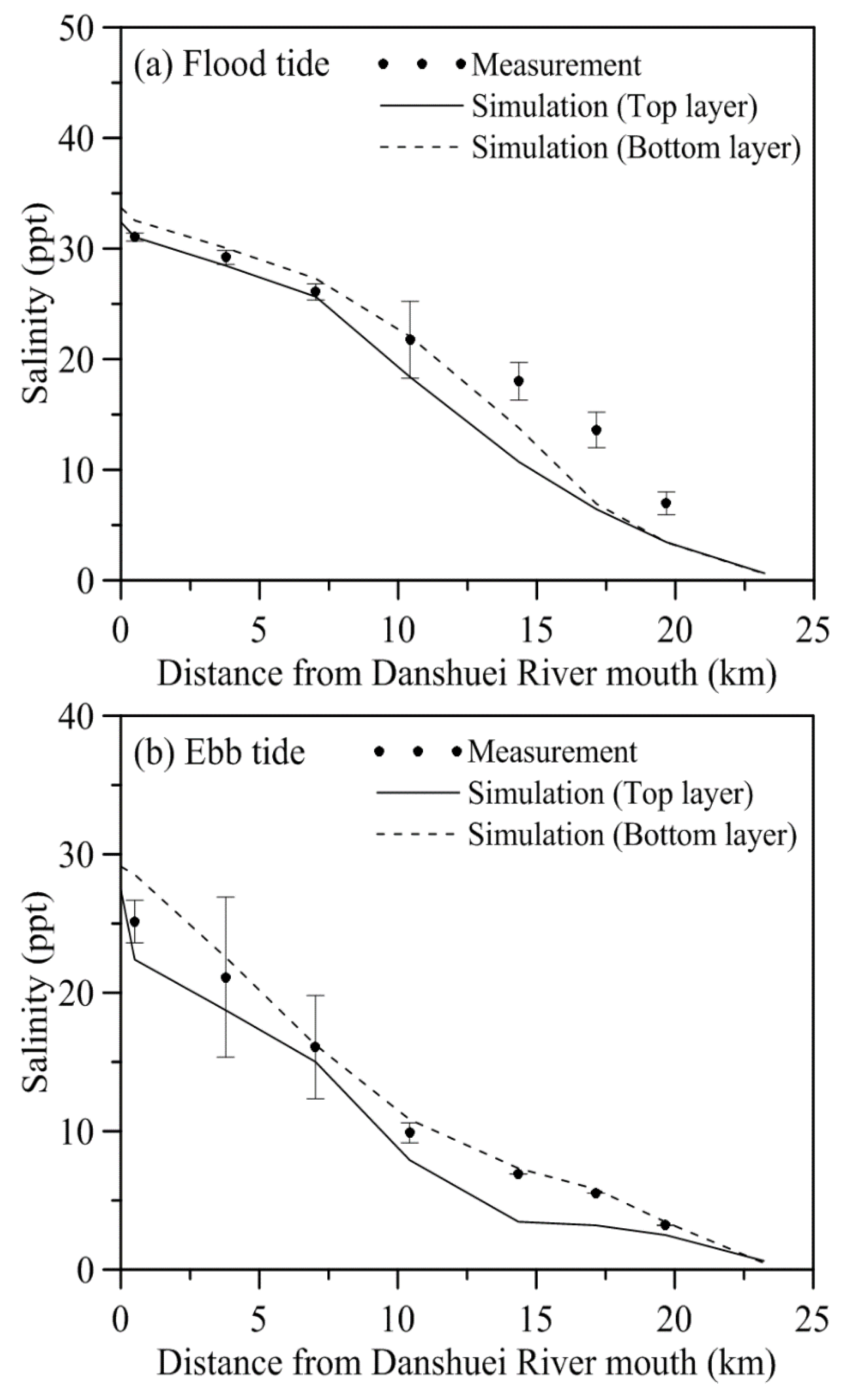
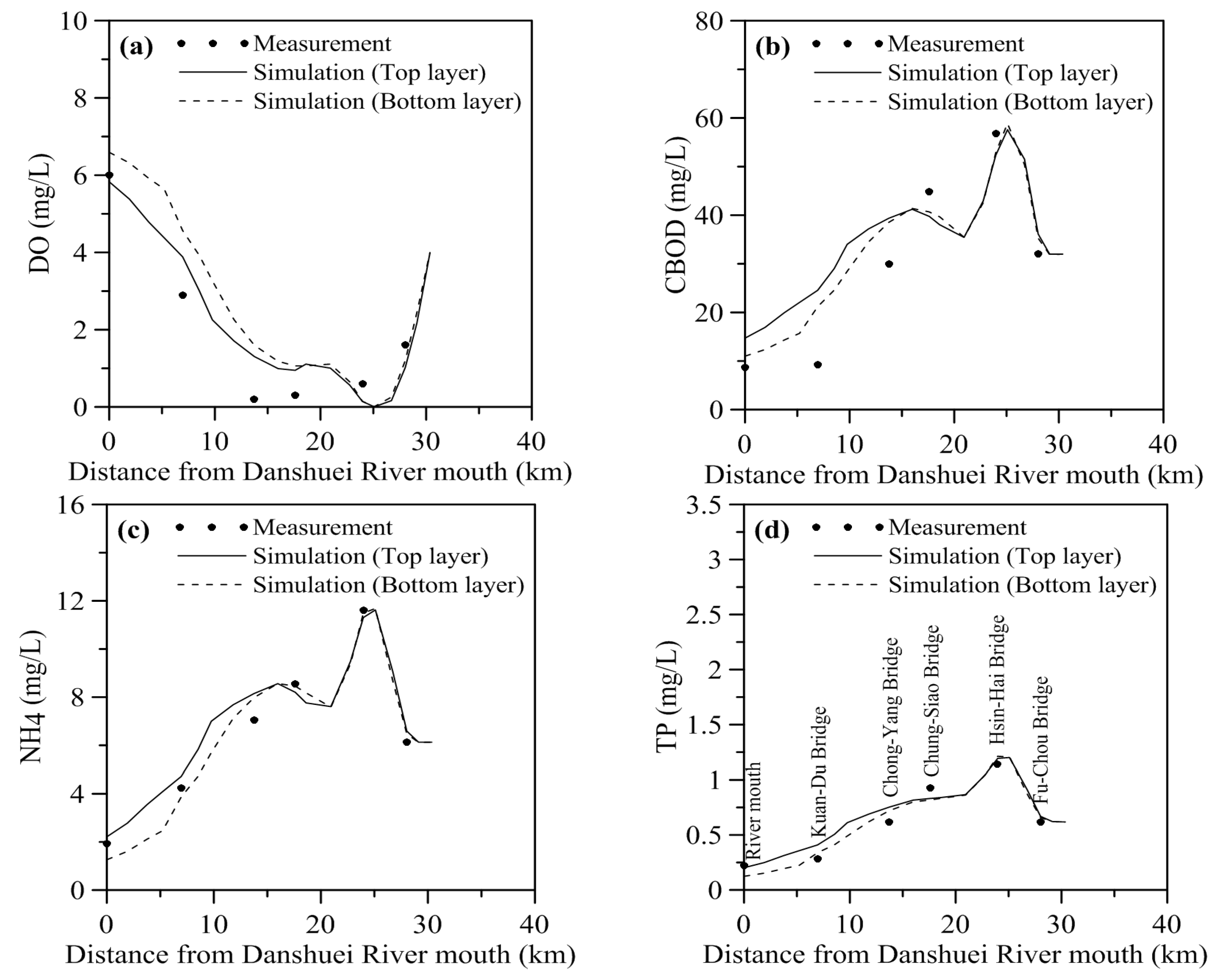
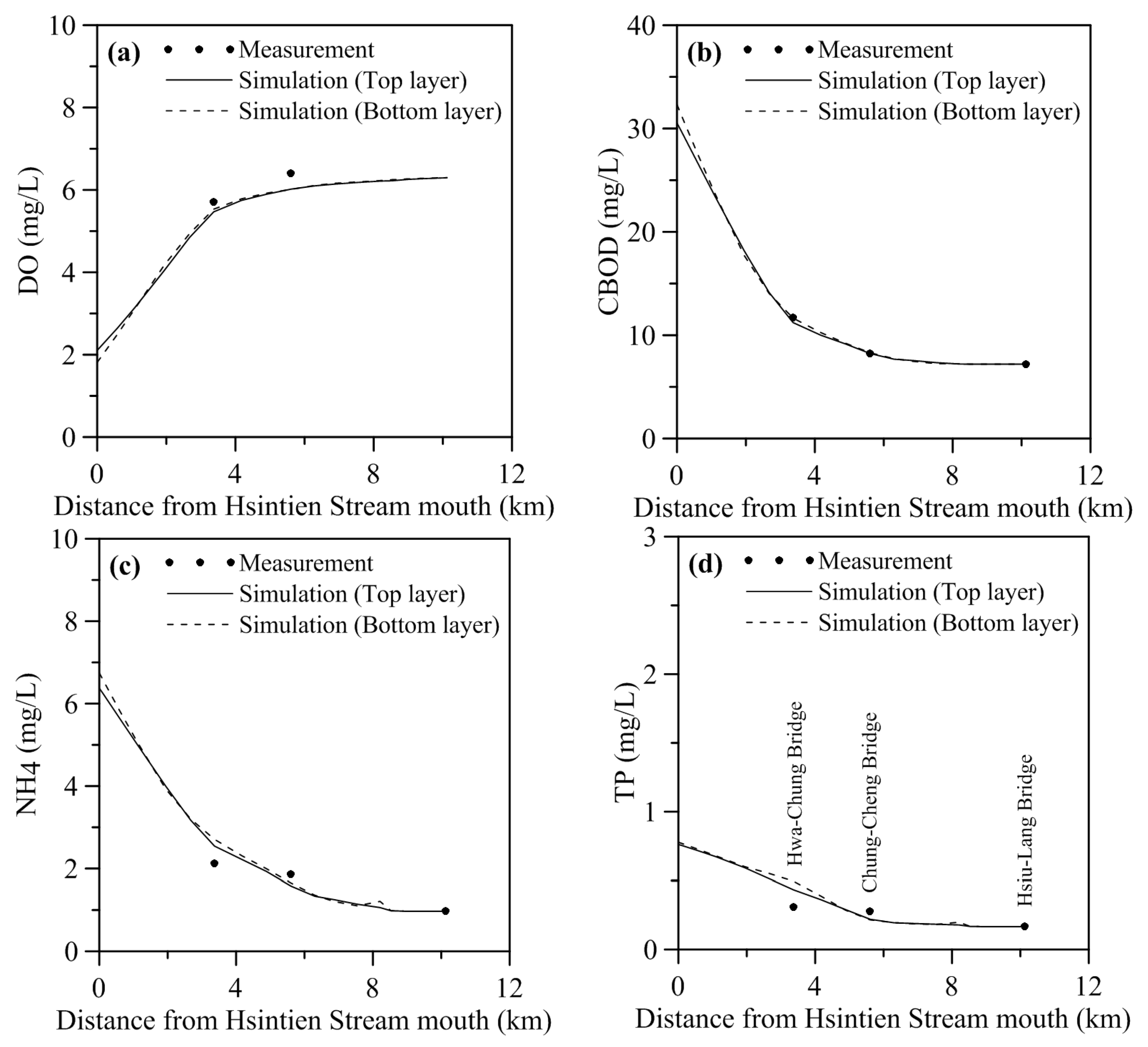

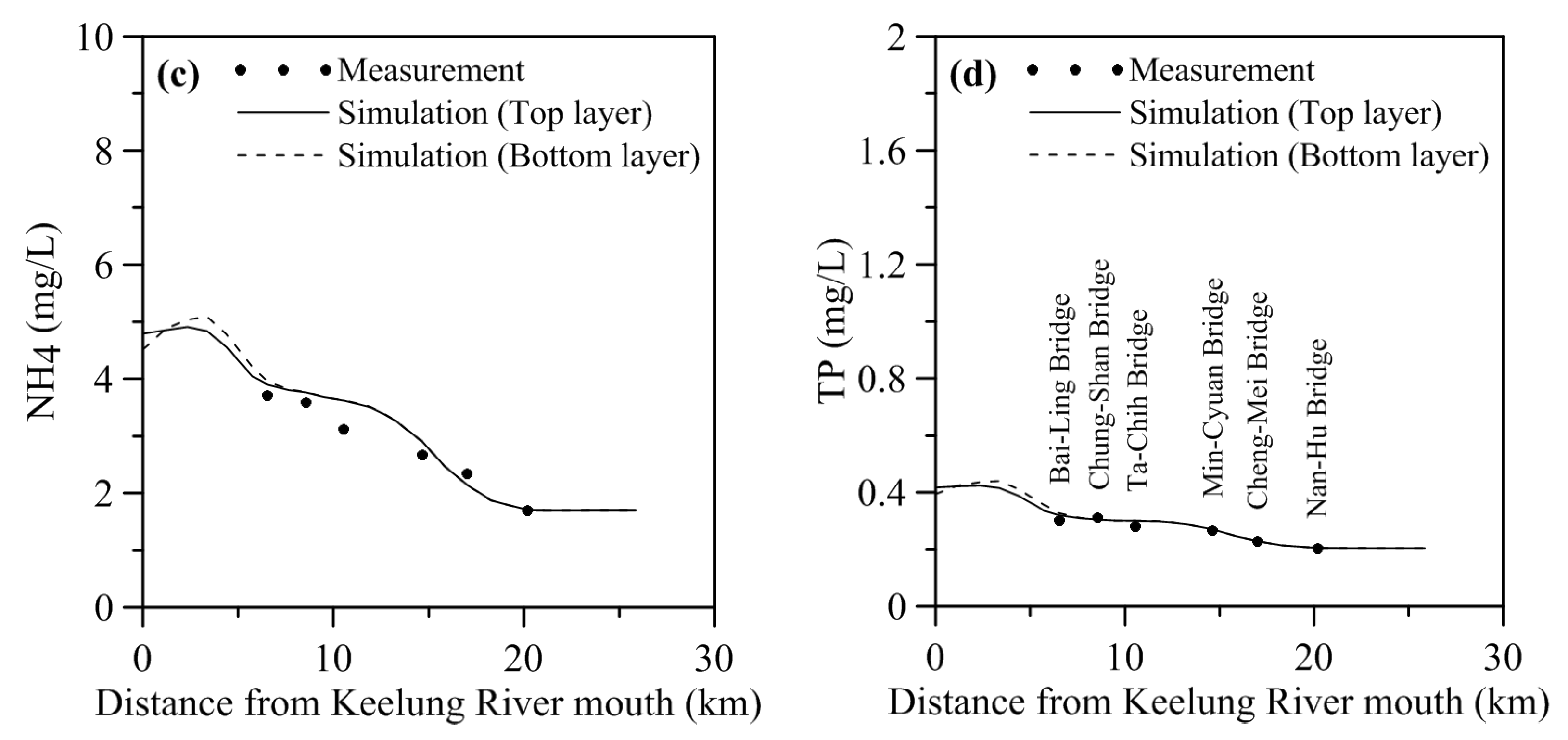



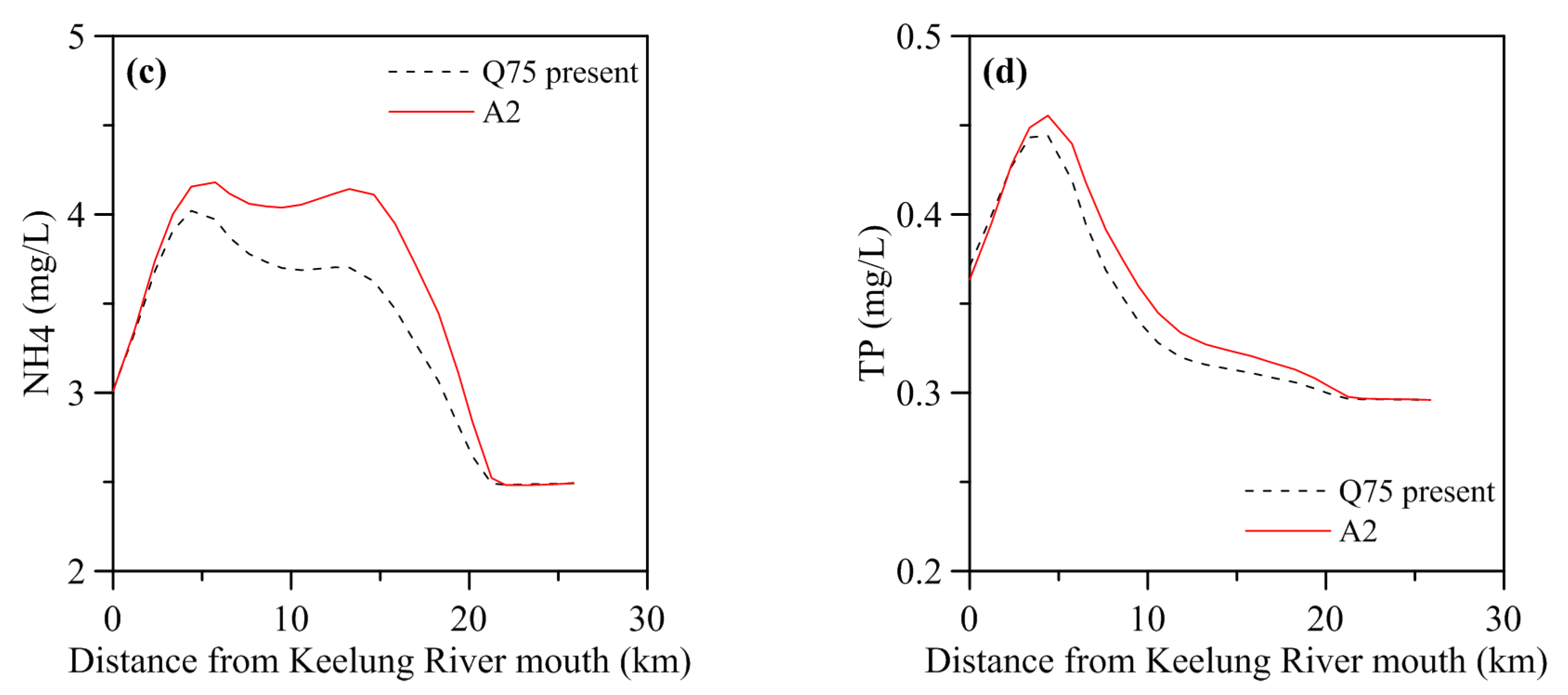
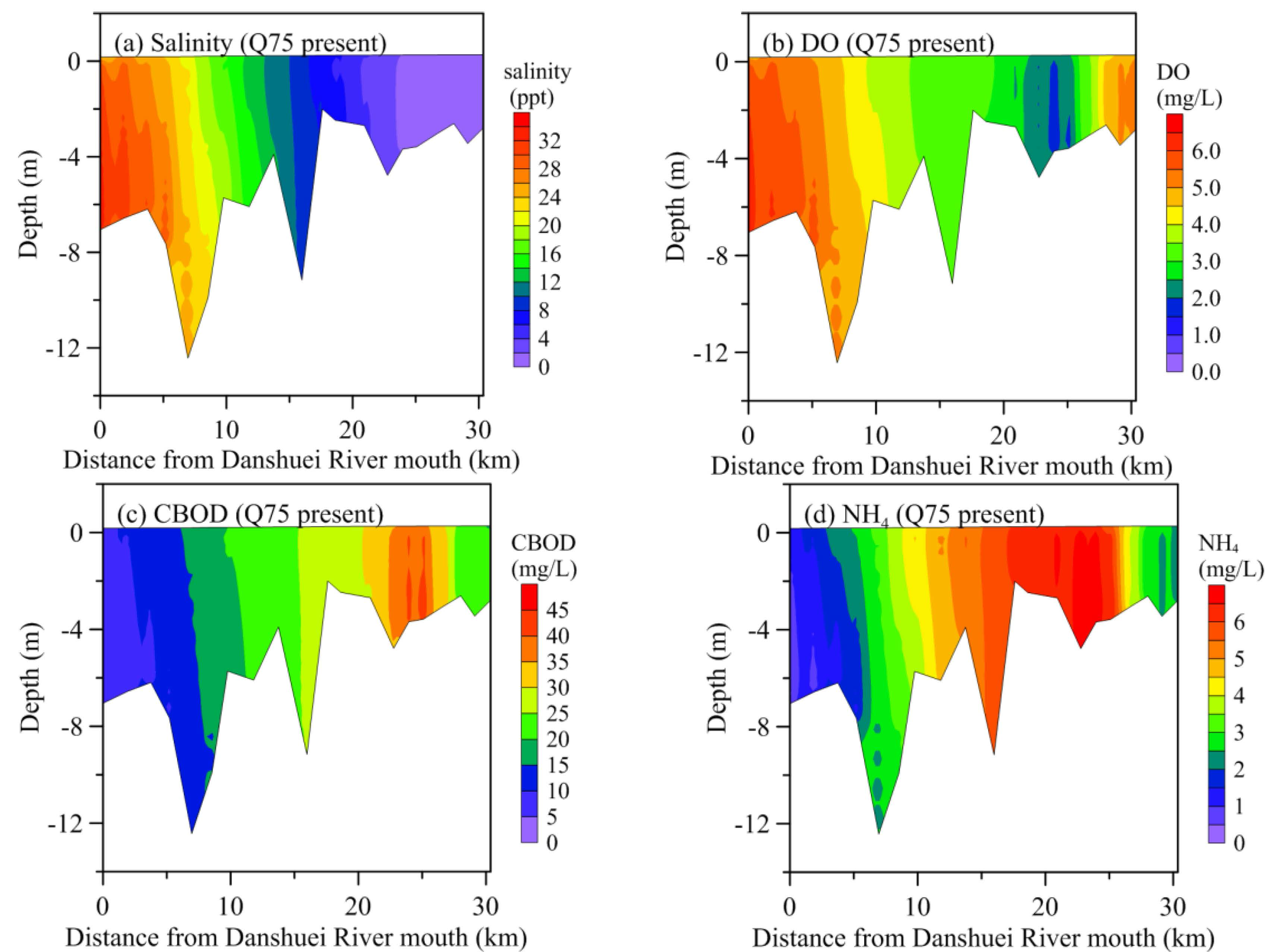
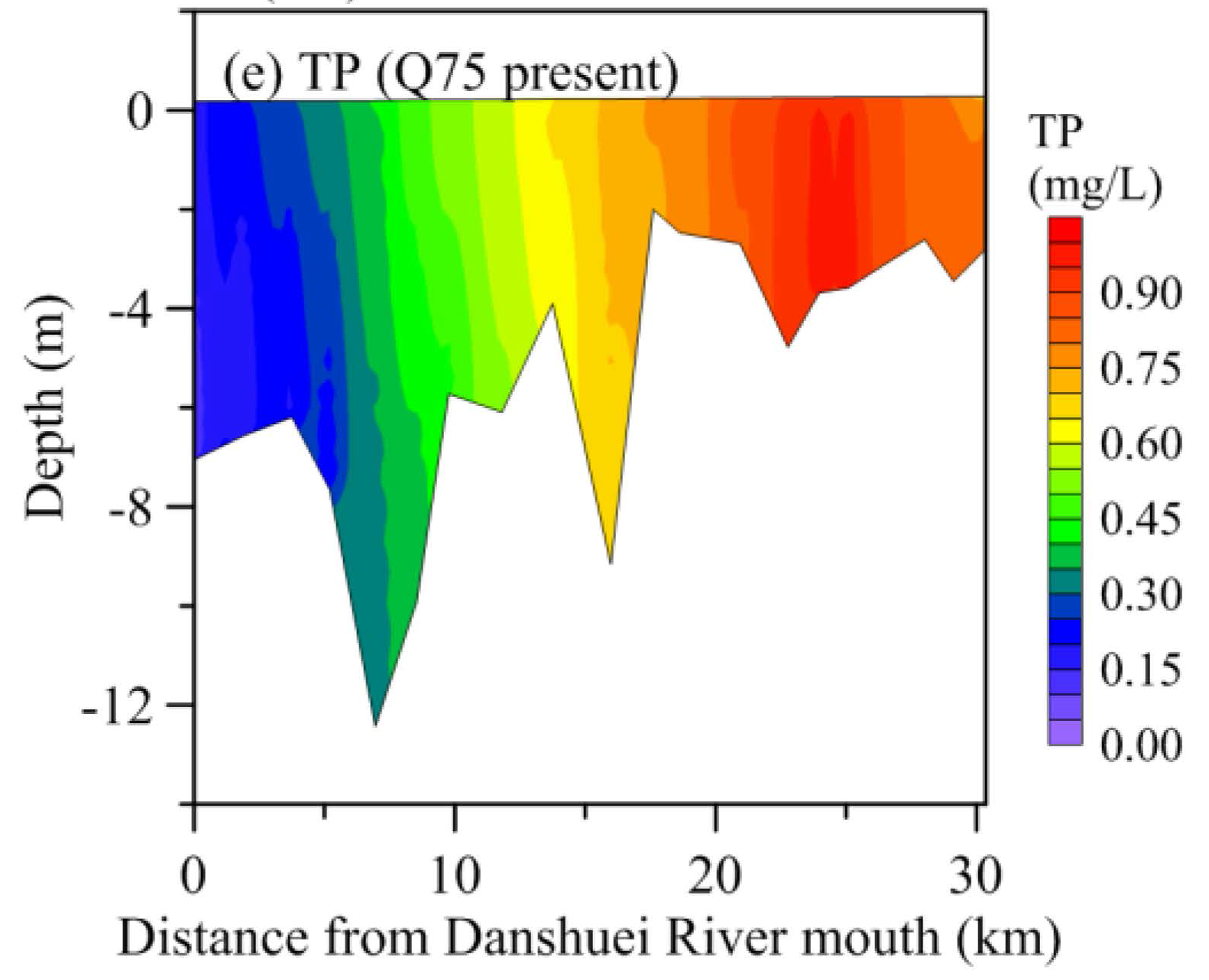
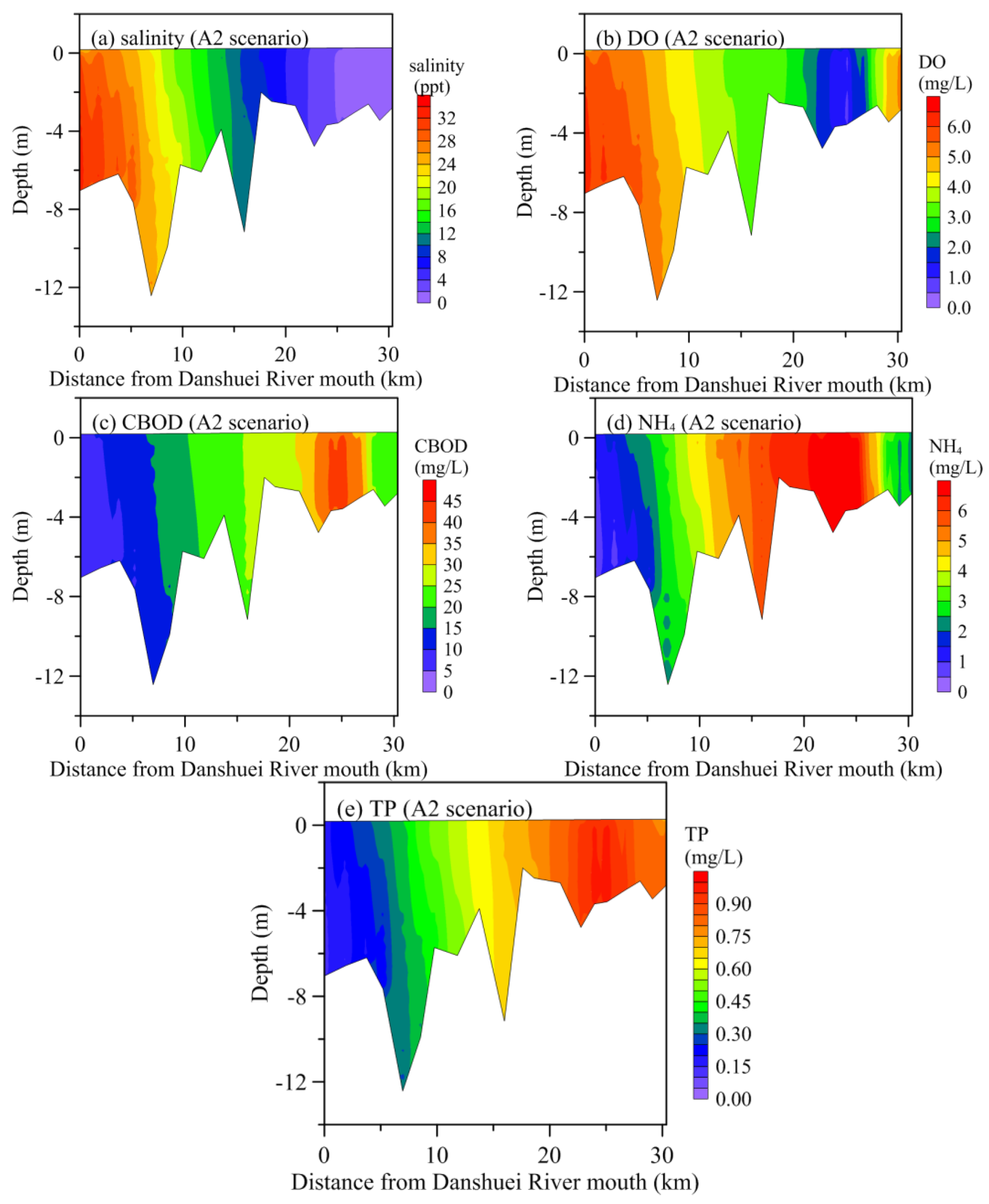
| Coefficients | Value | Unit |
|---|---|---|
| Deoxygenation rate at 20 °C | 0.16 | day−1 |
| Nitrification rate at 20 °C | 0.13 | day−1 |
| Phytoplankton respiration rate at 20 °C | 0.6 | day−1 |
| Denitrification rate at 20 °C | 0.09 | day−1 |
| Organic nitrogen mineralization at 20 °C | 0.075 | day−1 |
| Organic phosphorus mineralization at 20 °C | 0.22 | day−1 |
| Optimum phytoplankton growth rate at 20 °C | 2.5 | day−1 |
| Optimal temperature for growth of phytoplankton | 16 | °C |
| The morality rate of phytoplankton at 20 °C | 0.003 | day−1 |
| Half-saturation constant for oxygen limitation of carbonaceous deoxygenation | 0.5 | mg O2 L−1 |
| Half-saturation constant for oxygen limitation of nitrification | 0.5 | mg O2 L−1 |
| Half-saturation constant for uptake of inorganic nitrogen | 25 | μg N L−1 |
| Half-saturation constant for uptake of inorganic phosphorus | 1 | μg P L−1 |
| Half-saturation constant for oxygen limitation of denitrification | 0.1 | mg O2 L−1 |
| Half-saturation constant of phytoplankton limitation of phosphorus recycle | 1 | mg C L−1 |
| Sediment oxygen demand at 20 °C | 3.5 | g/m2 day |
| Optimal solar radiation rate | 250 | langleys/day |
| Total daily solar radiation | 300 | langleys/day |
| Ratio of nitrogen to carbon in phytoplankton | 0.25 | mg N/mg C |
| Ratio of phosphorus to carbon in phytoplankton | 0.025 | mg P/mg C |
| Ratio of phytoplankton to carbon | 0.04 | mg Phyt/mg C |
| Organic carbon (as CBOD) decomposition rate at 20 °C | 0.21 | day−1 |
| Anaerobic algae decomposition rate at 20 °C | 0.01 | day−1 |
| Denitrification rate at 20 °C | 0.01 | day−1 |
| Organic nitrogen decomposition rate at 20 °C | 0.01 | day−1 |
| Organic phosphorus decomposition rate at 20 °C | 0.01 | day−1 |
| Benthic NH4 flux | 0.04 | mg N day−1 |
| Benthic NO3 flux | 0.003 | mg N day−1 |
| Benthic PO4 flux | 0.005 | mg P day−1 |
| Ratio of nitrogen to carbon | 0.01 | mg N/mg C |
| Ratio of phosphorus to carbon | 0.01 | mg P/mg C |
| Water Quality Variable | Danshuei River–Tahan Stream | Hsintien Stream | Keelung River | |||
|---|---|---|---|---|---|---|
| AME (mg/L) | RMSE (mg/L) | AME (mg/L) | RMSE (mg/L) | AME (mg/L) | RMSE (mg/L) | |
| Dissolved oxygen | 0.63 | 0.88 | 2.17 | 3.47 | 0.91 | 0.98 |
| Carbonaceous biochemical oxygen demand | 2.21 | 2.79 | 1.79 | 2.29 | 2.02 | 2.51 |
| Ammonium nitrogen | 0.36 | 0.54 | 0.52 | 0.74 | 0.15 | 0.19 |
| Total phosphorus | 0.07 | 0.10 | 0.08 | 0.12 | 0.008 | 0.01 |
| Water Quality Variable | Danshuei River–Tahan Stream | Hsintien Stream | Keelung River | |||
|---|---|---|---|---|---|---|
| AME (mg/L) | RMSE (mg/L) | AME (mg/L) | RMSE (mg/L) | AME (mg/L) | RMSE (mg/L) | |
| Dissolved oxygen | 0.74 | 0.85 | 0.86 | 1.18 | 0.38 | 0.45 |
| Carbonaceous biochemical oxygen demand | 6.56 | 7.5 | 0.11 | 0.16 | 1.25 | 1.67 |
| Ammonium nitrogen | 0.35 | 0.46 | 0.25 | 0.32 | 0.23 | 0.27 |
| Total phosphorus | 0.08 | 0.08 | 0.07 | 0.09 | 0.01 | 0.01 |
| Water Quality Variable | Danshuei River–Tahan Stream | Hsintien Stream | Keelung River | |||
|---|---|---|---|---|---|---|
| AME (mg/L) | RMSE (mg/L) | AME (mg/L) | RMSE (mg/L) | AME (mg/L) | RMSE (mg/L) | |
| Dissolved oxygen | 0.83 | 0.97 | 0.29 | 0.44 | 0.68 | 0.76 |
| Carbonaceous biochemical oxygen demand | 2.48 | 2.84 | 2.23 | 2.85 | 1.60 | 1.86 |
| Ammonium nitrogen | 0.52 | 0.80 | 0.44 | 0.67 | 0.35 | 0.42 |
| Total phosphorus | 0.99 | 0.10 | 0.08 | 0.14 | 0.06 | 0.07 |
| Water Quality Variable | Danshuei River–Tahan Stream | Hsintien Stream | Keelung River | |||
|---|---|---|---|---|---|---|
| AME (mg/L) | RMSE (mg/L) | AME (mg/L) | RMSE (mg/L) | AME (mg/L) | RMSE (mg/L) | |
| Dissolved oxygen | 1.41 | 1.65 | 0.67 | 0.83 | 1.04 | 1.19 |
| Carbonaceous biochemical oxygen demand | 1.10 | 1.32 | 006 | 0.07 | 0.80 | 0.91 |
| Ammonium nitrogen | 0.47 | 0.78 | 0.03 | 0.04 | 0.56 | 0.71 |
| Total phosphorus | 0.04 | 0.06 | 0.01 | 0.01 | 0.02 | 0.02 |
| River | Q75 Low Flow under Present Condition (m3/s) | Decreasing Rate under A2 Scenario (%) | Q75 Low Flow under A2 Scenario (m3/s) | Decreasing Rate under A1B Scenario (%) | Q75 Low Flow under A1B Scenario (m3/s) |
|---|---|---|---|---|---|
| Tahan Stream | 3.36 | 45.54 | 1.83 | 19.05 | 2.72 |
| Hsintien Stream | 14.23 | 4.15 | 13.64 | 3.44 | 13.74 |
| Keelung River | 3.33 | 45.65 | 1.81 | 24.32 | 2.52 |
| River | Maximum Rate under Climate Change A2 Scenario | Maximum Rate under Climate Change A1B Scenario | ||||||
|---|---|---|---|---|---|---|---|---|
| DO (%) | CBOD (%) | NH4 (%) | TP (%) | DO (%) | CBOD (%) | NH4 (%) | TP (%) | |
| Danshuei River–Tahan Stream | −59.4 | 20.46 | 26.9 | 4.4 | −25.8 | 7.5 | 9.8 | 1.8 |
| Hsintien Stream | −2.0 | 1.9 | 3.8 | 1.7 | −1.9 | 1.6 | 3.0 | 1.6 |
| Keelung River | −33.7 | 4.9 | 13.8 | 6.2 | −14.5 | 2.3 | 6.2 | 3.3 |
| River | Present Condition (km) | A2 Scenario (km) | A1B Scenario (km) |
|---|---|---|---|
| Danshuei River–Tahan Stream | 24.67 | 26.19 | 25.24 |
| Hsintien Stream | 3.06 | 3.31 | 3.20 |
| Keelung River | 11.29 | 12.62 | 11.80 |
© 2016 by the authors; licensee MDPI, Basel, Switzerland. This article is an open access article distributed under the terms and conditions of the Creative Commons by Attribution (CC-BY) license (http://creativecommons.org/licenses/by/4.0/).
Share and Cite
Liu, W.-C.; Chan, W.-T. Assessment of Climate Change Impacts on Water Quality in a Tidal Estuarine System Using a Three-Dimensional Model. Water 2016, 8, 60. https://doi.org/10.3390/w8020060
Liu W-C, Chan W-T. Assessment of Climate Change Impacts on Water Quality in a Tidal Estuarine System Using a Three-Dimensional Model. Water. 2016; 8(2):60. https://doi.org/10.3390/w8020060
Chicago/Turabian StyleLiu, Wen-Cheng, and Wen-Ting Chan. 2016. "Assessment of Climate Change Impacts on Water Quality in a Tidal Estuarine System Using a Three-Dimensional Model" Water 8, no. 2: 60. https://doi.org/10.3390/w8020060






